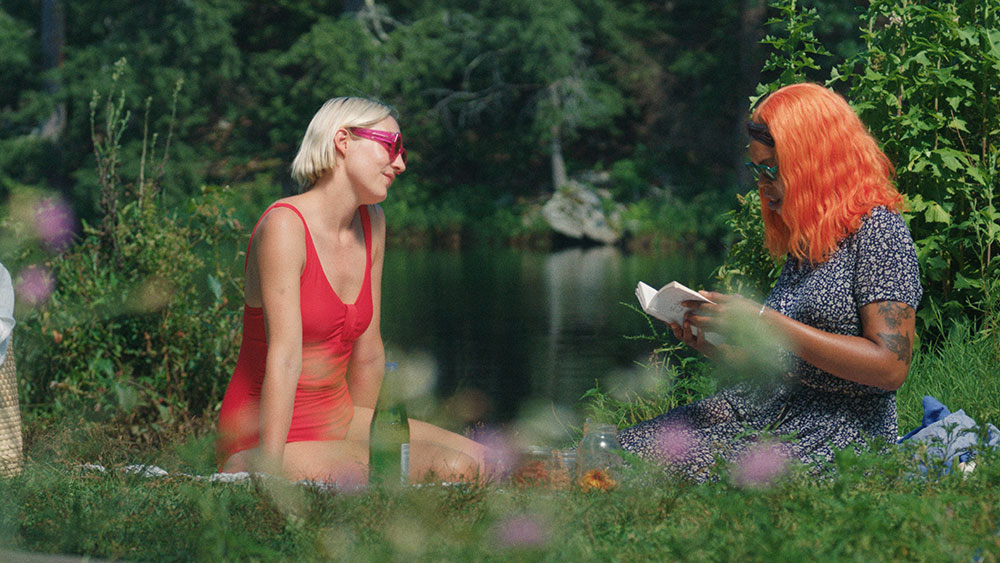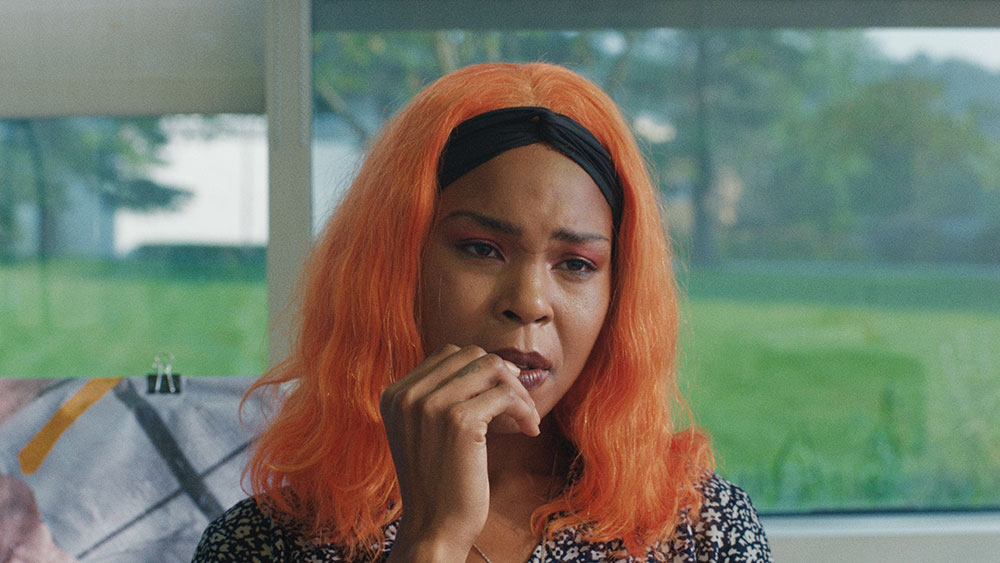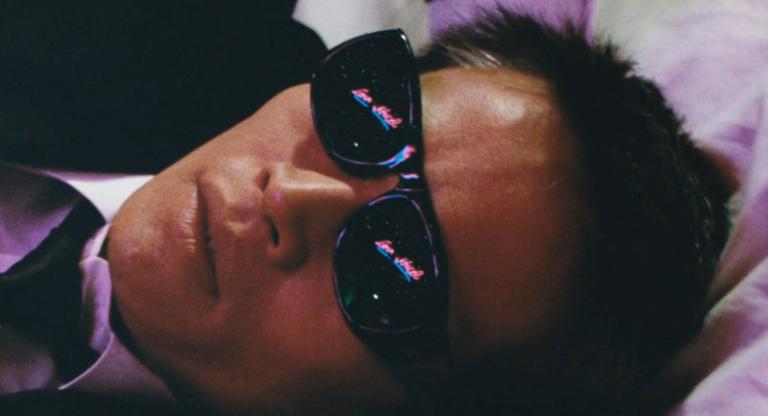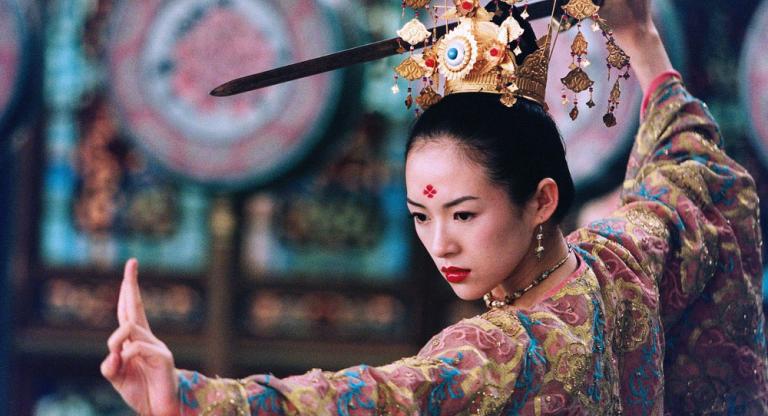The African Desperate makes a critical comedy of misunderstandings and failures to listen—from linguistic slippages to willful ignorance. Martine Syms takes us through twenty-four hours in the absurd institutional caverns of grad school, shot on and around the campus of Bard College, from which Syms received her MFA. Palace (Diamond Stingily) endures a final review from an all-white faculty board and struggles to avoid the year-end party on her way out of town, dealing simultaneously with traumatic memories and the pressure to perform conviviality with her peers. Syms’s multifarious visual art practice has included one previous feature-length film installation—Incense, Sweaters, & Ice (2017)—but The African Desperate is her first intended for the cinema.
On the occasion of the film’s premiere as the Closing Night selection of New Directors/New Films 2022, I spoke with Syms about setting the terms of one’s participation with institutions, balancing the responsibilities of a caretaker with the expectations of professional visibility, and identifying the art world as a perfect backdrop for the ironies and anxieties of inclusion.
Amber Esseiva: I wanted to start with the title, The African Desperate. For me, that has a lot of connotations, being a woman of color working within institutions. Something that I was noticing, especially in the opening scene, between Palace and her reviewers, is this somewhat desperate exchange of what we give to institutions for validations. And then what institutions expect from us: just being in the room and being part of their quota.
Martine Syms: The character is trying to say “the African diaspora” and makes a mistake. That scene was one of the first that I had written. A lot of my work deals with failures of communication or misunderstanding. I think in those kinds of settings, there's a feeling that people are intentionally misunderstanding you. They’re kinda committed to misunderstanding. So I liked the idea that this character could make a mistake, but it would just get wrapped into the conversation because no one was really listening to her anyway. And she's kind of nervous. That was the initial thinking [behind the title]. But I think it's really evocative, and all the other meanings that it conjured I was really excited about.
AE: It made me think about isolation and loneliness, which has a lot to do with being misheard or not heard. And that seemed to be also very palpable in the film, from very simple things like, “No, I'm not coming to the party,” to the nature of how that crit unfolded. Obviously, it's metaphorical, but like a lot of things that are art world–related, also not.
MS: There's a kind of desperation to grad school. It’s really hard to avoid, no matter who you are. It's palpable in the environment.
AE: Speaking of grad school, and speaking of the environment, I also went to Bard. So watching this film, I could pinpoint half of the places you were. It felt so familiar to me, even the houses, and the dialogue, and so much about it. Obviously, you had gone to Bard and had a specific experience, like we all had, but I wondered how much of this for you felt autobiographical or how interested you are in that.
MS: It’s autobiographical in a way, but also my co-writer [Rocket Caleshu] went to grad school. And some of the experiences I was drawing from are also Diamond [Stingily]’s, who has had a really different experience in the art world, but also operates in these kind of elite spaces similarly. I also have taught in grad [school] and undergrad. So it's a combination of all my education plus teaching and other experiences with the institution. I had the most access to Bard because I'm an alum. But someone who recently graduated from Bennington saw it and came up to me and was like, “There were four of us there.” [laughs]
I think what I wanted to hit on is not so much my specific experience at Bard—though using my specific experience. [I wanted to] talk about what it feels like to be at one of these institutions, especially one that is supposedly progressive or radical. When I taught at CalArts, they were doing this study, this HR research, and I remember they had this big faculty meeting to talk about the findings, one of which was—surprise, surprise—a lot of people of color feel the institution is often racist. And it's like, we needed to bring someone else in to say that? We’ve been saying that. You know, like, it’s said.
Bard is where I went for grad school, but I went to the School of the Art Institute [of Chicago] for undergrad. And at the time that I went there, it was not a very diverse place, despite Chicago being a city with a very large population of Puerto Rican [and] Black people. Like me and a handful of other people I still know [were] the only students of color there.

AE: And one can say the same for any kind of institution, especially in the US. It could be a museum, it could go way beyond grad school. And it's still kind of similar.
MS: In the workplace. My siblings also have different experiences. Very different industries, but working in politics, working in finance. I decided to talk about the art industry, specifically, because I thought people seem really fascinated by it right now. And I wanted to make a movie that felt accurate to that world. But I think it fits for a lot of different places. I also think that's the thing that's part of the desperation. Like, I want to participate. You know, to be clear, I made a choice a long time ago to participate. This is the world I wanna work in, but that doesn't mean it always feels good. Sitting with that kind of conflict is a big part of my life.
AE: Yeah, I talk about that a lot. Even after you've done a dream project—whatever that means—and everything's produced well and looks good, you're stuck sitting with the fact that the process didn't feel good. And it's like you gotta reconcile those two things that are really confusing.
MS: Exactly.
AE: So I want to talk about when you bring in the testament of the dead daughter, and you bring in Diamond’s mom at the end. That really hit me. You know, that's also my experience being, I guess, this kind of motherless person navigating in the world that, as a result, makes for a lot of desperate decisions. I want to hear more about why and what way that came in, and why that reference specifically.
MS: The testament of the dead daughter was a text that Diamond told me about a few years ago—— that's her copy of the book in the film. It was republished by Cabinet Gallery, which is a gallery she shows with in London. I'm really involved in art publishing, and so I came across it—Diamond recommended it, and I picked up a copy of it. I really loved it. And the interesting thing about the book is [that] actually maybe the father figure is the more conflicted one in it. It's talking about light, like actual illumination. When you see something, or when you learn something, and then you can't unsee it anymore. In this text, there's sort of a parable where the daughter sees and the father is trying to discourage this kind of vision.
But the invocation of the mother [in the film] is very much about this position that women are often required to perform for people, especially Black women—like caretakers, mothering, support. I think that figure historically is something that's come into my work. When I was in grad school, my mother was really sick. And I was caretaking. It was a part of my life that nobody really knew while I was in school. At the same time, in my career, I was in a moment of increased visibility. And that was really difficult for me, because there was very little understanding that something else might be happening to me besides superficial art world success, whatever that means. It wasn't like financial. [laughs] It was just very visible. But I was still taking my mom to doctor's appointments.
AE: Yeah, I feel you on that.
MS: I didn't feel like I had to tell anybody about that, because the majority of people I went to school with weren't my friends and actually didn't care about me. So why would I be so vulnerable, you know what I mean? I think that's something that the two of us shared is this experience of caretaking. It's hard to explain unless you have chronic illness or you have been close to someone with it. It's a real experience with death.
AE: And it kind of drags on, and it's day to day. I mean, it happened to me. I was in high school, so it was a different circumstance. But yeah, it's the way that it stretched time. It's very specific.
MS: I just wanted to try and put that experience in. There's always the clichés like, “You never know what anyone's going through.” But I wanted to try and show what that might look like. And also thinking about what Diamond said to me, maybe after I gave her the first draft. She was like, “I remember one time I was talking to you [in school], and you were so upset. And I was like, ‘Why don't you just leave?’” And I guess I said to her something like, “I can't just leave, Diamond! I need to finish this. I can't just leave.” It’s like, I want to be here, I need to be here.
Trying to contain the wholeness of that kind of experience [in the film] was really exciting to me. That's what I wanted to try and capture, why you can't just leave. Even though that would have been the move. Like why I needed— You know, I'm saying I, but really the character is a combination of me, Diamond, and Rocket in a way: those qualities, those experiences. But also, it's a figure that we can use to think about these decisions.

AE: This sentiment around care and obligation, and the impulse and therefore maybe even the inability to leave, leads me to the next question, which is about the format of time. The kind of twenty-four-hours-in-a-day structure of the film makes me think of The Breakfast Club or even about other artworks that think about this, like Christian Marclay’s The Clock [2010]. What led you to that decision?
MS: I've always loved movies like that. Two of my favorite movies are La Haine and Friday [both 1995], both of which have a twenty-four-hour structure. Part of what I love about cinema is the play with time, the stretching or the collapsing of space and time. And I felt like this was the way I could give the broadest sense of the [graduate] program without having to give a lot of backstory. Like start with what in most movies would be the end: graduation, or this final crit. This person’s worked so hard to come to this final crit. I liked the idea of starting there and ending with a kind of non-arrival. Like you talked about, when you do a dream project and you're kind of like, “Oh, okay. It's cool, I'm glad I did that.” But there's a little bit of a realization that there is nothing on the other side of the curtain, ever.
AE: I'd say my experience with grad school and thesis was the most anti-climactic feeling in the world.
MS: I think those moments are what I'm drawn to, cinematically. Trying to capture what that kind of in-between space feels like. There's a way to make everything feel so monumental, and I’m kinda interested in the mundane.
AE: I had another question for you about the use of memes in the film. Memes, especially the good ones, feel like inherently part of a Black internal monologue that the world gets to see and make viral. The way that you use them in the film really highlighted the way in which those thoughts get formed.
MS: All of the memes—and a lot of the stills and the kind of dream sequences—were things I shot during my time at Bard. I kind of went through my own photo archive. When we did our thesis show, everybody was supposed to post on the [program’s] Instagram, and I didn't want to do it. It was probably kind of shitty of me, but I just made all these memes, and I just posted my memes. It didn't go over well, but that was kind of the point.
It's like all of the moments that Larry David or [Jerry] Seinfeld try to talk about, [which] do that same work of this very specific affect. In the function of the film, it serves as a memory or something. Maybe after you see it, you're thinking about the Kermit meme, and you're like, “When did I see that? Why is that in my head?” Throughout the film, there's kind of a push on interiority and exteriority and how maybe sometimes Black women are— people desire a kind of performance from them, whether that's of happiness, or sadness, or anger—
AE: Or vulnerability.
MS: Yeah, exactly, or vulnerability. And things are often interpreted in a hyper-performative way. Even if you're just doing nothing, you're like reading a book. I liked that the memes were one other way of showing Palace’s interiority and what her perspective was.
AE: I was also struck by the final scene and the final monologue. You know, this kind of sublime setup where you're panning the landscape, which is whatever, bucolic and “beautiful.” My first question is where that monologue comes from. The tension it created was super powerful. It kind of felt like it was going on throughout the whole film, but it was just at the end.
MS: That was a video that was circulating on . . . Vine? No, not Vine. I don't remember what platform it was circulating on initially. Maybe Twitter. It's this man quitting [his job], and he’s so pissed off. I have felt that way, you know what I mean? I definitely did projects I've left where finally you want to tell everybody how you felt. I was joking with somebody; I was like, “Just in case you didn't get that she doesn't like it.” [laughs] Like, “Just in case there's a way you can construe it that like, ‘Oh Palace was just upset about something.’” And make it personal, you know? I wanted to indict.
Something I really liked about Afropessimism [2020], Frank Wilderson's book, is that there is a glee to the rage. There’s humor to it. Whenever I've been really mad, sometimes it makes me laugh, because it's so absurd. And even in the introduction of Paul Beatty's book [Hokum], the anthology he did about Black humor. He talked about being punched in the face, but smiling into it. I think like, yeah, that bittersweet or that sense of humor—you're aware of it. You're always aware [of] . . . these microaggressions. You are very aware of why, when they're happening, but there's not a lot you can do in the moment. So some of it gets turned into a joke. [Other times] your response becomes equally absurd. And I wanted some space to— Yeah, I wanted it to take up a lot of space.
I love that video [the monologue] is from. We tried a few different versions. We tried it where Diamond is performing that monologue. And I think the beauty of Upstate really belies this kind of weirdness. I find it to be a very strange place. [laughs] It is gorgeous, but there's always this undertone. I've had so many fucking weird-ass experiences up there, it’s not really worth recounting. As I'm sure you have, being familiar with it. So I liked to indict the landscape, the people, everything that's supposedly so nice about it. And you go, “Well, why is it that? Does everyone feel that way?”
AE: To put it as an indictment is really brilliant. That’s exactly what it's doing.
MS: And because I have the interstitial [shots] of the landscape before, it changes how those function. And that's what I wanted to do in the context of the film.
AE: Picking up on this predisposition to thinking about things like microaggressions as being the perfect fix for a situational comedy, I was thinking about your experience making a feature film, if you plan on making more or working in this form in the future.
MS: Yeah, I would love to. I’m writing another film right now. When the idea serves it, I'm thinking about it. I feel like it's very aligned with my artwork, and it makes sense to continue. Some ideas, [an] exhibition serves best, and other ideas a film would be best. So I'm writing another film right now that I'd like to do that's a feature. I also have a bunch of shows coming up. So I'm trying to figure out how to do all of it.
AE: Some people describe producing a film as one of the most collaborative mediums. Did you find that to be true?
MS: Yeah, I did. I had the most brilliant collaborators. That was really why it was able to be done. From Rocket, my co-writer, to Diamond, who was the lead, to the other performers in the film to Daisy Zhou, who was such an amazing cinematographer, to Vic Brooks, who was another producer, [and] Ways & Means, a production company I worked with here in LA. All these people were really why I was able to do it. And that felt a bit different from some of the other work that I do, [where] it's me driving every single part of it. It was really fun to be collaborative. Every part of it is with all these other people. The energy that's there, the mood that's there—if there's a conflict there, that's what you're working with.
Over the past few years, I've been working with actors more and more. It's something I’d like to do more of. The more I work with trained actors, the more I want to do, because it changes my writing so much and opens up all these other dimensions and colors to the film. I'm very holistic. Obviously, we work together and there's no hierarchy in it with me, but it's more like the depth. I feel like I'm just getting deeper into my interests and my inquiries. I'd like to keep doing that.
The African Desperate screens tonight, April 30, at Film at Lincoln Center, and tomorrow, May 1, at the Museum of Modern Art, as the Closing Night selection of New Directors/New Films 2022. Director Martine Syms will be in attendance for Q&As.



